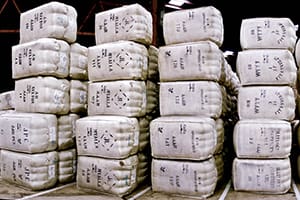 Fine crossbred wool, Merino skirtings and carding wools sold dearer in Australian sales this week.
Fine crossbred wool, Merino skirtings and carding wools sold dearer in Australian sales this week.
But medium and broader Merino wool, and coarse crossbred lines lost ground as the AWEX-Eastern Market Indicator closed up one cent to 1093c/kg clean.
Brokers passed in 6.4 percent of the 43,442-bale offering with the Australian dollar on US77.36 cents and the EMI in US dollars closing down 16 cents to US846 cents.
AWEX senior market analyst Lionel Plunkett said most of the Merino sector gained a few cents on the opening day before reversing direction on Thursday and closing largely unchanged for the week.
“The only exception was in the broader categories which lost ground over both days.
“The 21 to 23-microns have outperformed the overall market in recent times.
“But during this series they were as much as 20 cents cheaper – the broader the micron, the worse the result,” he said.
Aussie dollar has big one day surge
Mr Plunkett said the weaker fleece sector on the final day coincided with a strengthening Australian dollar that had its biggest one-day surge in almost two years.
“The AUD initially jumped almost two cents during Thursday morning trade on the back of a selloff in the greenback.
“It closed the day in the mid 77-cent range after briefly hitting 78 US cents.”
Mr Plunket said Merino skirtings had a similar result to the fleece catalogue and generally closed in line with the previous week. An exception was the solid result in the 17-18 microns.
He said the 25 and 26 micron crossbreds were the standout performers at up to 20 cents dearer in Melbourne. Merino carding types were also well sought after and closed out the week around 20 cents higher.
Medium and broad Merino wool back 10-25 cents
Australian Wool Innovation consultant Scott Carmody said the upsurge in the Australian dollar at the end of the week appeared to put a cap on the upswing of the past few weeks, but the AWEX-EMI level is nearing six percent better than at the same time last year.
“In the ever diminishing super fine (16.6 to 18.5micron) and ultrafine (16.5 micron and finer) Merino fleece offering, prices remained generally fully firm for the week, with the better specified wool types adding just a couple of cents to their value.
“The superior end of the best top making and spinners descriptions were almost impossible to find, but the few lots available traded at similar levels seen over the past two or three weeks,” he said.
“The fine wool (18.6 to 20.5 micron) Merino fleece was well sought throughout the selling week with some very good wools on offer attracting full and strong attention from all operators.
“Quotations barely moved after the opening day saw significant Chinese buying interest,” Mr Carmody said.
He said the medium and broad (20.6 to 24 micron) Merino fleece segment didn’t fare well and struggled to maintain price levels.
“Interest appeared minimal throughout the week from both the forward sellers and indent buyers in a larger offering.
“As a result prices were generally 10 to 25c/kg clean kg lower by the close of selling on Thursday afternoon.”
He said demand was strong for Merino skirtings.
“An improvement in price was witnessed across the offering towards the close, and most quotes on the better skirting types ended the week being 5 to 10c/kg clean kg dearer.”
Most carding wools lift up to 30 cents
Most carding wools were upwards of 30c/kg clean kg dearer and further into record levels, Mr Carmody said.
All carding indicators showed 20c/kg clean kg rises with carbonizing types heavily sought after.
“All types suitable for open/broken top production managed to just hold the large gains extracted last week, although a slight pull back late in selling was seen.“
Fine crossbreds 15-20 cents dearer
Crossbred and comeback (25 to 32micron) fleece maintained the pattern of the past month with the finer types (25 to 27 micron) were dearer by 15 to 20c/kg clean kg, the middle microns (28 to 30 micron) very firm to slightly dearer by 5c/kg clean kg and the broader types (31 micron plus) struggling to hold onto the quoted levels, he said.
“The next two weeks of selling have around 43,000 bales scheduled to be auctioned each week, followed by a week of no sales.
“With the local market battling hard and holding ground against a detrimental US v AD exchange, firm to dearer markets should be expected.”
Sources: AWEX and Australian Wool Innovation.

HAVE YOUR SAY